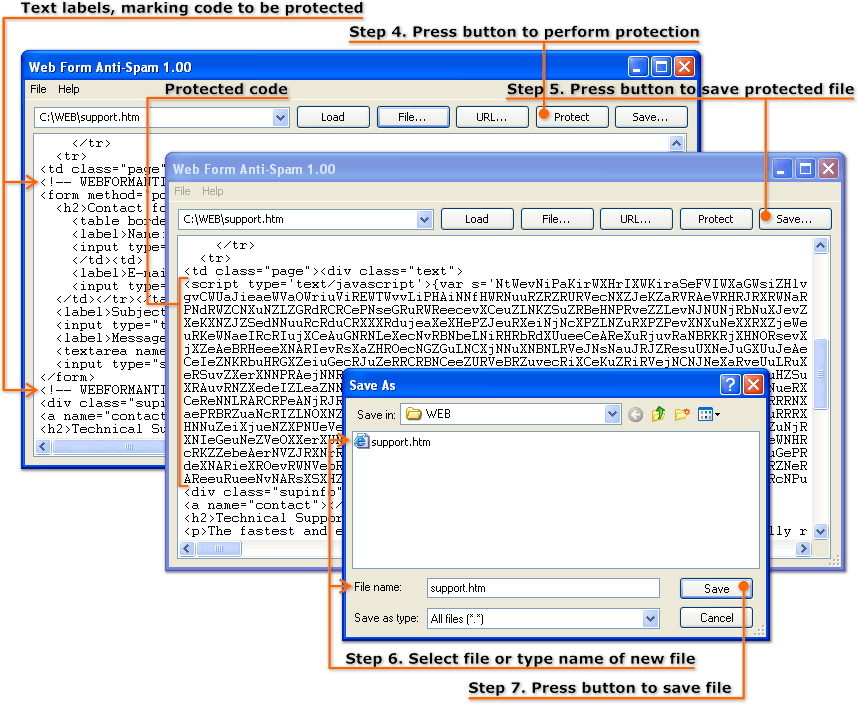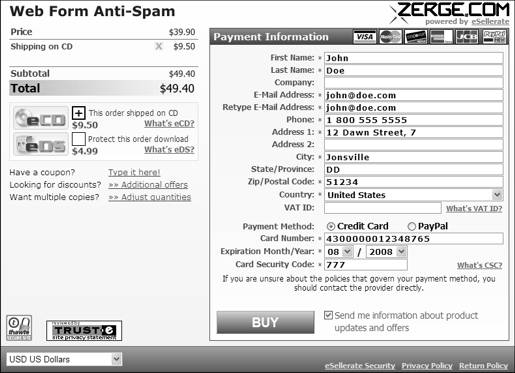Facing the problem
Spam – it is now an unfortunate but inevitable problem of the internet. As most webmasters now realize, by operating an interactive website that contains at least one web form (eg registration, feedback, comments, forum messages, etc), spambots are highly likely to discover and plague a website. These nasty creations crawl across web pages and inundate forums, filling in web forms and sending spam information to the webmaster, website and site visitors (eg by means of a forum).
The true nature of spambots
Spambots are automated programs, actively surfing the web by successively following hyperlinks while searching for web forms. Once a spambot finds a form, it parses and analyzes the form; if the form is suitable for spam purposes, it is recorded by the spambot for further use. How do spambots then use these web forms? They fill them with unwanted information, hyperlinks and visuals that are intended to attract a target audience. If a spambot is unable to read a HTML code describing the form contents, then the bot simply omits that code.
Email harvesting bots
These troublesome critters crawl the web masquerading as spambots, collecting email addresses published on web-pages. Once discovered, these email addresses are fed back to spam databases for subsequent use during mass mailout campaigns. It is possible to block thousands of incoming spam emails, although there is a risk of mistaken identity and deletion of acceptable messages. Bots can also be prevented from reading email hyperlinks by making HTML code that renders them as unreadable by bots.
Common solutions
Many sites now use CAPTCHA, a method that requests visitor verification by copying the digits and letters disguised in random pictures.
Pros: Image recognition is one of the hardest operations for computer programs, while it is the natural skill of human computer users
Cons: Site visitors are required to undertake unexpected tasks. It is not user-friendly practice to make visitors carry out solutions to your problems
Cons: Your visitor is required to have pictures display enabled in their browser
Cons: People with visual impairment using screen readers will be unable to recognize CAPTCHA pictures
Cons: To enable CAPTCHA-based web form protection, server-side components and/or scripts have to be used; this is not always possible and requires advanced skills in web programming
Replacing email hyperlinks with graphics (i.e. ![]() ), can help in hiding an email address from harvesting.
Pros: To read an email address, the harvesting bot again needs to recognize images, which is both difficult and time consuming
), can help in hiding an email address from harvesting.
Pros: To read an email address, the harvesting bot again needs to recognize images, which is both difficult and time consuming
Cons: Instead of one click to open an email client and start a message, the visitor is required to open the email client and type the email address letter by letter, with the risk of mistyping and sending the message to the wrong address
Cons: People with visual impairment using screen readers will not be able to recognize the email address
Cons: As with CAPTCHA, a visitor is required to have pictures display enabled in the browser
A better solution against spambots!
Web Form Anti-Spam is a utility for Windows that converts any HTML code into a script tag with JavaScript enclosed within it. When displayed in a web browser, like Internet Explorer, the JavaScript will expand itself and decode into original HTML code, so the browser can display the same result as it was in the original HTML source. This means that your site visitors will not notice the protection and will never be annoyed by counter-measures against spambots.
HTML code obfuscator „Web Form Anti-Spam”
Free Trial Download: 2.83 MB, ver. 1.00.0.40, 19 May 2009.
(for Windows 2000, Windows XP and Windows Vista)
Web Form Anti-Spam is available for Windows 2000/2003, Windows XP and Windows Vista.
Demo version is free to download and use for evaluation purposes during 15 days.
Many things in the world can be easily explained using illustrations.
Please look at the screenshots below, which were taken from user manual:

This is how protection is carried out: you load the source HTML code, like the web form in the above example, and press the "Protect" button. In less than a second you can take out the code, which is protected and ready to be inserted into a web page.
This is all that’s required! You can protect any part of the HTML code from different threats, such as spambots and email harvesting bots. This method also protects against plagiarism – although it is still possible to copy final text, a potential thief will be unable to view your source HTML code because it is encoded.
Anti-spam protection: evidence it works!
This web page has been protected using Web Form Anti-Spam in order to demonstrate it really works, and guard us against spambots and email harvesting bots. Please note: this will not be apparent if you are using a JavaScript-enabled web browser. You can find protected code by looking at the HTML code of this web page. Yes, we use our software, and we receive no spam!
Trial Version Download: 2.83 MB, 1.00.0.40, 19 May 2009.
(for Windows 2000, Windows XP and Windows Vista)
Can Web Form Anti-Spam protect server forms?
If you will encode server-side form, server will not be able to process it to produce HTML code for the client. To protect forms for FrontPage Server Extensions, ColdFusion and similar, you will need to obtain the client code they produce and encode that plain HTML rather than server script. For example, if you will encode HTML for FrontPage Server Extensions, "webbot" markers will become hidden and server will not recognize that JavaScript as FrontPage form.
To resolve this, we are working on server-side component for applying protection on the fly, just after server generates HTML. More details about protecting FrontPage web forms can be found in the article: "Protecting FrontPage web forms against spam bots".
Web Form Anti-Spam for advanced users
Don't Let 'em Any Chance!
...The coolest way about the proposed method of protection is that your human visitors eventually won’t notice any protection and can contact you easily, while the automated bots, on the contrary, won’t notice any contacting method!..
Web Form Anti-Spam protects files against spambots in the same way as partial HTML code. It can also encode the whole web page, which in most cases is excessive, so partial file protection is also provided. To see what we mean, please take a look at the screenshots above once more. You will notice that the resulting protected code consists of encoded and normal parts. This is because text labels are present in the source HTML code, which tell the utility exactly what should be protected and what should remain unchanged. The markers are HTML comments in the above example, although it is possible to define your own markers and undertake custom protection.
The powerful features of the Web Form Anti-Spam utility can be used with command-line mode. This allows automating and batch protection of not only a single web page, but also a series of pages requiring protection. This means that it is possible to have a one-click button for applying web page anti-spam protection for all your website pages.
Order now: protect all your web pages against spambots!
You can order a copy of Web Form Anti-Spam online. Ordering is fast and safe, and you will receive a key code immediately after order processing. Web Form Anti-Spam is available at our online store. Alternatively, you can order it by pressing the "Buy" button inside the program.
This will initiate your key code automatically, avoiding the need to copy it from an order confirmation e-mail: 
eSellerate Inc.
5901 North 58th Street
Lincoln, NE 68507-3249, USA
You can feel safe using your credit card here without risk. We process all orders on the secure servers of eSellerate, one of the most reliable names in online order processing:
Web Form Anti-Spam: 15 day trial
You can try Web Form Anti-Spam before purchasing. Use, learn, and evaluate the utility over a free 15 day trial period! If you like it, we fully expect you will want to buy the full version.
Trial Version Download: 2.83 MB, 1.00.0.40, 19 May 2009.
(for Windows 2000, Windows XP and Windows Vista)
Contact us via the web form, protected against spambots!
To contact us, please use the form below. If you look at the HTML code of this page, you will notice that the form is encoded with our software. There is no CAPTCHA present, and we receive no spam through this form!
If you prefer to email, please write to us at . This email hyperlink is also protected against email harvesting bots with Web Form Anti-Spam! We cannot claim to have no spam in our mailbox because it is widely used across the Internet. However, we are sure that no spam database with email addresses has been fed with our address from this page.
Online technical support is also available by ICQ:  492-744-423.
492-744-423.
Need more information?
We offer online help (as shipped with the Web Form Anti-Spam software) here on our site:
Web Form Anti-Spam Online Help.
Here you will find all that you need to know about how to use Web Form Anti-Spam for protecting your web pages against spam robots. Topics include reference information, screenshots, step-by-step instructions and more.
You may also want to read the articles about blocking web form spambots and how to make web form protection against spam bots user-friendly.
The latest article is Protecting FrontPage web forms against spam bots, it is dedicated to protecting particular kind of web forms (FrontPage) against spam bots.







